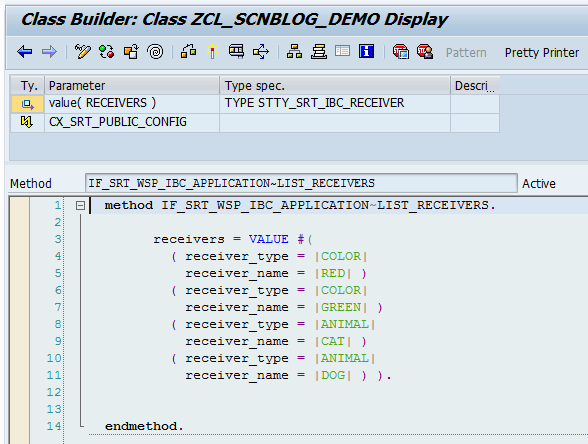
- SAP Community
- Groups
- Interest Groups
- Application Development
- Blog Posts
- Integration and Connectivity in ABAP – Part 7
- Subscribe to RSS Feed
- Mark as New
- Mark as Read
- Bookmark
- Subscribe
- Printer Friendly Page
- Report Inappropriate Content
One of the key concepts introduced in ABAP 7.40 involves the addressing of entities at a finer granular level than the client. These entities are called Identifiable Business Contexts (IBCs). Some of the advantages of IBCs are:
- By addressing business entities instead of technical systems, your application scenarios will be more robust because of the decoupling of business and technical configuration. The scenarios will be independent of hardware, for example.
- The size and complexity of messages will be reduced because some information for processing messages that was previously included in the payload is not needed.
- Security can be enhanced because you can restrict access to dedicated business entities rather than giving general client level access.
If you want to know more, see the documentation Semantic Addressing Using Identifiable Business Contexts (IBCs) . To take away some of the mystery, I provide screenshots here illustrating where you can find IBCs and how to create your own.
Client IBCs
Each client has an IBC of its own that is automatically generated. So you can still do client-level addressing without creating other IBCs. Here is transaction SOAMANAGER:

In a managed landscape, the central system has an automatically generated IBC reference for each system client in the landscape, including itself.

Creating Your Own IBCs
Before you can create an IBC, there needs to be a class in the system that specifies the types and names that are allowed to be created. Here is transaction SE24:

The class must implement the interface IF_SRT_WSP_IBC_APPLICATION.


I only need to implement the LIST_RECEIVER_TYPE and LIST_RECEIVERS. I chose silly values for this demonstration so that they are easily identified and understood in the following screenshots.


Once the class is activated, it is visible in transaction SOAMANAGER. At this point there are no IBCs or IBC references based on the class.

What I am about to show is not recommended. In general applications should create IBCs, but it is easier to understand if I show the manual way.
In a managed system, I now create an IBC.

I choose Create and then, on the following screen, Save.

Now the IBC is visible when I search for it.

Now in the central system there is an IBC reference that has been automatically generated.

Conclusion
There is nothing difficult about creating IBCs and IBC references, and they open up a whole load of new possibilities.
- SAP Managed Tags:
- ABAP Connectivity
You must be a registered user to add a comment. If you've already registered, sign in. Otherwise, register and sign in.
-
A Dynamic Memory Allocation Tool
1 -
ABAP
8 -
abap cds
1 -
ABAP CDS Views
14 -
ABAP class
1 -
ABAP Cloud
1 -
ABAP Development
4 -
ABAP in Eclipse
1 -
ABAP Keyword Documentation
2 -
ABAP OOABAP
2 -
ABAP Programming
1 -
abap technical
1 -
ABAP test cockpit
7 -
ABAP test cokpit
1 -
ADT
1 -
Advanced Event Mesh
1 -
AEM
1 -
AI
1 -
API and Integration
1 -
APIs
8 -
APIs ABAP
1 -
App Dev and Integration
1 -
Application Development
2 -
application job
1 -
archivelinks
1 -
Automation
4 -
BTP
1 -
CAP
1 -
CAPM
1 -
Career Development
3 -
CL_GUI_FRONTEND_SERVICES
1 -
CL_SALV_TABLE
1 -
Cloud Extensibility
8 -
Cloud Native
7 -
Cloud Platform Integration
1 -
CloudEvents
2 -
CMIS
1 -
Connection
1 -
container
1 -
Debugging
2 -
Developer extensibility
1 -
Developing at Scale
3 -
DMS
1 -
dynamic logpoints
1 -
Eclipse ADT ABAP Development Tools
1 -
EDA
1 -
Event Mesh
1 -
Expert
1 -
Field Symbols in ABAP
1 -
Fiori
1 -
Fiori App Extension
1 -
Forms & Templates
1 -
General
1 -
Getting Started
1 -
IBM watsonx
1 -
Integration & Connectivity
9 -
Introduction
1 -
JavaScripts used by Adobe Forms
1 -
joule
1 -
NodeJS
1 -
ODATA
3 -
OOABAP
3 -
Outbound queue
1 -
Product Updates
1 -
Programming Models
14 -
Restful webservices Using POST MAN
1 -
RFC
1 -
RFFOEDI1
1 -
SAP BAS
1 -
SAP BTP
1 -
SAP Build
1 -
SAP Build apps
1 -
SAP Build CodeJam
1 -
SAP CodeTalk
1 -
SAP Odata
1 -
SAP UI5
1 -
SAP UI5 Custom Library
1 -
SAPEnhancements
1 -
SapMachine
1 -
security
3 -
text editor
1 -
Tools
17 -
User Experience
5
| User | Count |
|---|---|
| 5 | |
| 3 | |
| 3 | |
| 3 | |
| 2 | |
| 2 | |
| 2 | |
| 2 | |
| 1 | |
| 1 |